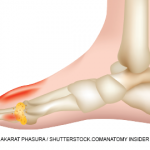ATLANTA—The authors of the new draft ACR treatment guideline for the management of gout presented the draft guideline on Nov. 13 at the 2019 ACR/ARP Annual Meeting. Based on evidence from more than 130 published studies, there are 42 recommendations, of which 16 were strong, including 27 for urate-lowering therapy (ULT) management, 13 of which were strong; five each for managing gout flares and lifestyle recommendations; four for management of other medications for patients with gout; and one for asymptomatic hyperuricemia management. The previous ACR gout guidelines were published in 2012.
“We are now preparing the manuscript for journal peer review, and then need to have a final approval vote by the board of directors prior to publication,” said John D. FitzGerald, MD, PhD, co-principal investigator of the new guideline and past chair of the ACR’s Quality of Care Committee. Following the board’s approval, simultaneous publication in Arthritis & Rheumatology and Arthritis Care & Research is expected in 2020.
The guideline was developed using GRADE (Grading of Recommendations Assessment, Development and Evaluation) methodology and included input from an eight-patient panel and consideration of therapies’ cost based on average wholesale pricing for each drug, said Dr. FitzGerald, a rheumatology researcher at the University of California, Los Angeles (UCLA) David Geffen School of Medicine. To assess risk of bias of evidence, guideline investigators used the Cochrane risk-of-bias tool for randomized controlled trials and the ROBINS-I (Risk of Bias in Non-Randomized Studies—of Interventions) tool for observational studies.
New Strong Recommendations
Sixteen strong recommendations included changes from the 2012 guidelines, such as a recommendation for following a treat-to-target strategy of dose management when treating all gout patients with serum urate-lowering therapy (ULT) that includes dose titration and subsequent dosing guided by serial serum urate values to achieve a target over a fixed, standard dose ULT strategy, and a new recommendation for all patients on ULT to continue therapy to achieve and maintain a target of 6 mg/dL over using no target.
Other strong recommendations include:
- Initiating ULT in gout patients with one or more subcutaneous tophi over no ULT;
- Initiating ULT in patients with radiographic damage, using any modality, that is attributable to gout;
- Initiating ULT in patients with frequent gout flares, or two or more per year;
- Use of allopurinol as the first-line ULT, including in gout patients with stage 3 or worse chronic kidney disease (CKD);
- When using allopurinol or febuxostat as ULT, starting at low dose, with subsequent dose titration to target over a higher dose, such as 100 mg/day or less for patients taking allopurinol or a lower dose for patients with chronic kidney disease, and 40 mg/day or less for patients taking febuxostat;
- Use of concomitant anti-inflammatory prophylaxis over no prophylaxis when patients start ULT for at least three to six months, rather than less than three months, with evaluation and continued prophylaxis if the patient keeps having flares;
- Use of colchicine, non-steroidal anti-inflammatory drugs or glucocorticoids as appropriate first-line therapy for gout flares over interleukin (IL) 1 inhibitors or adrenocorticotropic hormone (ACTH);
- When colchicine is the chosen agent for managing a gout flare, use of low-dose over high-dose colchicine given its similar efficacy and less adverse effects; and
- For patients with gout who have failed to achieve serum urate targets with xanthine oxidase inhibitors (XOIs), uricosurics and other interventions, and who have frequent gout flares or non-resolving tophi, switching to pegloticase over continuing the current ULT.
Pegloticase, HLA-B*5801 & Lifestyle Changes
The guideline also includes strong recommendations against the use of pegloticase as a first-line urate-lowering therapy. In patients who have infrequent gout flares and no tophi, but have not achieved the serum urate target despite xanthine oxidase inhibitors, uricosurics and other interventions, a strong recommendation is made against switching to pegloticase over continuing their current therapy. However, for patients who have failed xanthine oxidase inhibitors, uricosurics and other interventions, a strong recommendation is made to switch to pegloticase.


